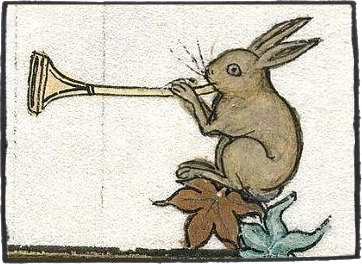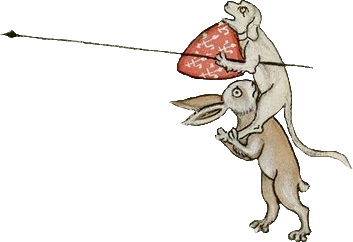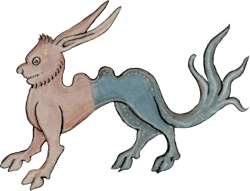The Fabled Hare

The Fabled Hare The Folklore of Rabbits
I sall goe intill ane haire,
With sorrow and sych and meikle caire,
I sall goe in the Divellis nam,
Ay whill I com hom againe
It appears that the nostalgic image of the flop eared bunny has suffered a decline over the last several years. Used as an example as a derogatory references to Witch folk who only seem to be able to practice within the realms of sweetness and light, the image of our furry friend has become synonymous with unbalanced and unfortunately what is somewhat considered by some to be diminished traits when used a symbol for allegory. It wasn’t always this way. The rabbit has served as a role model in many various forms representing the vicissitudes that life puts before us and signifying transitional and transformative elements that speak to the deeper parts of our psyche in many ways for many centuries. The lore of the rabbit or hare has been encoded into the mythologies of many cultures and even into a myriad of songs and ballads as the title for this essay shows, The Fabled Hare, which was borrowed from the haunting and evocative song of the same name by Maddy Prior.
On the Silver Screen the rabbit has assumed various familiar, identifiable forms that make us take deeper, introspective looks within ourselves, from the campy, cartoon antics of everyone’s favorite wascally wabbit, Bugs Bunny, to the more recent image of the surreal character of Frank the Bunny who comes to us from the instant cult classic film Donnie Darko. In between the ends to that spectrum are the treasured images of Jimmy Stewart and his invisible friend Harvey, who was able to stop time, as well as the many literary bunnies such as Peter Rabbit who comes to us straight from McGregor’s Farm and Garden with breath still scented from purloined carrots. Lewis Carroll too, immortalized his own White Rabbit, in his tales involving Alice and her journey Though the Looking Glass. This particular rabbit is another member from the family leporidae who seemed to be distinctly concerned with notions of time and timekeeping. And what child can forget the hi-jinks of the lovable General Mills Trix rabbit who never manages to succeed in obtaining the treasured bowl of Trix cereal?
Behind that twitching nose and those bright inquisitive eyes lurks another image of the rabbit, of the hare, a darker image that speaks of secrets held by shapeshifting Witches. This image is rife with the possibilities that go far and beyond the literary, allegorical world constructed by Richard Adams in his novel Watership Down. The hare has been used as a symbol of increase for centuries represented in the simple hieroglyphic form of a hare with a ripple of water below which stood for the verb to be or to exist and also in the more elaborate and detailed art works as shown by such artists as Albrecht Dürer.
This primal symbolism is recognized in the ideas and associations of the cunning fire or enlightenment itself shown by both the dawn as well as Spring, resurrection and new beginnings. Literally a companion to the Gods, the hare has been the attendant spirit to a Goddess known by many different epithets. According to Bede this Goddess, whose very presence represented the very fecundity of the Land, was known as by the Anglo-Saxon name Eostre and is also where the Christian festival named Easter is derived from. This Goddess was not only a representative of physical growth but also of the enlightenment of the soul through death, redemption and eventual rebirth.
Folklore abounds with references to local customary celebrations that incorporate the celebration of birth by the sacrifice of death with the demise of a hare having a prevalent theme. Hunting the Hare at Leicester (which took place at the bower of Black Annis) took place on the Monday after Easter up until the late eighteenth century. This was actually a mock hare hunt as a dead cat (which had been doused in water soaked with aniseed) was trailed from the tail of a horse about the countryside, eventually the cat made way to the door of the Mayor and the hounds and horsemen let loose to give chase. After the rigorous sport and raucous applause and much making of merry the town’s folk enjoyed treats and public celebrations at the behest of the Mayor himself.
Harvest celebrations did not forget the hare either. The hare is considered to be the vestigial spirit of the crops themselves, in most instances this crop was corn and the hare was ritually sacrificed at the end of the harvest season in such rites known as Killing the Hare or Cutting the Hare. The last stand of corn was taken up and gathered to create the hare, being divided up into three plaited parts and the ‘ears’ tied into a knot. The reapers would retire several feet away and throw their sickles in turn attempting to cut this last sheaf that represented the hare or spirit of the corn below the knot.
The hare also plays a prominent role in the trial of such infamous Witches as Isobel Gowdie. Gowdie’s trial, which took place in the year 1662 in the village of Auldearn, has been much publicized and is quite notorious for the fact that Isobel was not arrested or considered a practitioner of Witchcraft prior to her confession. She made no less than four complete confessions and those confessions were collected prima facie, which means that no torture was used to extract them. She freely and willingly volunteered up extremely intimate details about her induction into Witchery and to what celebratory occasions and what events she and many of her ill named village mates took part in from dancing the Gillatrypes to making rain fall from the sky with merely a stone and a wet cloth and a simple spoken charm. The charm for when she wished to shapeshift into a hare is this:
I shall go into a hare;
With sorrow and such and great care;
And I shall go in the Devil’s name
Until I come home again.
And when she wished to return to her own former status she would chant:
Hare, hare, God send thee care!
I am in a hare’s likeness just now
But I shall be in a woman’s likeness even now.
Further examples of the hare in folklore are as follows as shared below via excerpts culled from collected works by Robert Hunt and Edwin Sidney Hartland.
Witch & Hare
An old witch, in days of yore, lived in this neighbourhood; and whenever she wanted money she would assume the shape of a hare, and would send out her grandson to tell a certain huntsman who lived hard by that he had seen a hare sitting at such a particular spot, for which he always received the reward of sixpence. After this deception had many times been practised, the dogs turned out, the hare pursued, often seen but never caught, a sportsman of the party began to suspect, in the language of the tradition, “that the devil was in the dance,” and there would be no end to it. The matter was discussed, a justice consulted, and a clergyman to boot; and it was thought that, however clever the devil might be, law and church combined would be more than a match for him. It was therefore agreed that, as the boy was singularly regular in the hour at which he came to announce the sight of the hare, all should be in readiness for a start the instant such information was given: and a neighbour of the witch, nothing friendly to her, promised to let the parties know directly the old woman and her grandson left the cottage and went off together; the one to be hunted, and the other to set on the hunt.
The news came, the hounds were unkennelled, and huntsmen and sportsmen set off with surprising speed. The witch, now a hare, and her little colleague in iniquity, did not expect so very speedy a turn out; so that the game was pursued at a desperate rate, and the boy, forgetting himself in a moment of alarm, was heard to exclaim: “Run, Granny, run; run for your life!” At last the pursuers lost the hare, and she once more got safe into the cottage by a little hole in the door; not large enough to admit a hound in chase. The huntsman and all the squires with their train lent a hand to break open the door, yet could not do it till the parson and the justice came up; but as law and church were certainly designed to break through iniquity, even so did they now succeed in bursting the magic bonds that opposed them. Upstairs they all went. There they found the old hag bleeding, and covered with wounds, and still out of breath. She denied she was a hare, and railed at the whole party. “Call up the hounds,” said the huntsman, “and let us see what they take her to be; maybe we may yet have another hunt.”
On hearing this the old woman cried quarter. The boy dropped on his knees, and begged hard for mercy, which was granted on condition of its being received together with a good whipping; and the huntsman, having long practised amongst the hounds, now tried his hand on other game. Thus the old woman escaped a worse fate for the time present; but on being afterwards put on her trial for bewitching a young woman and making her spit pins, the tale just told was given as evidence against her, before a particularly learned judge, and a remarkably sagacious jury, and the old woman finished her days, like a martyr, at the stake.
Witch of Treva
Once a time, long ago, there lived at Treva, a hamlet in Zennor, a wonderful old lady deeply skilled in necromancy. Her charms, spells, and dark incantations made her the terror of the neighbourhood. However, this old lady failed to impress her husband with any belief in her supernatural powers, nor did he fail to proclaim his unbelief aloud.
One day this sceptic came home to dinner, and found, being exceedingly hungry, to his bitter disappointment, that not only was there no dinner to eat, but that there was no meat in the house. His rage was great, but all he could get from his wife was, “I couldn’t get meat out of the stones, could I?” It was in vain to give the reins to passion, the old woman told him, and he must know “that hard words buttered no parsnips.” Well, at length he resolved to put his wife’s powers to the proof, and he quietly but determinedly told her that he would be the death of her if she did not get him some dinner; but if in half an hour she gave him some good cooked meat, he would believe all she had boasted of her power, and be submissive to her for ever. St Ives, the nearest market-town, was five miles off; but nothing doubting, the witch put on her bonnet and cloak, and started. Her husband watched her from their cottage door, down the hill; and at the bottom of the hill, he saw his wife quietly place herself on the ground and disappear. In her place a fine hare ran on at its full speed.
He was not a little startled, but he waited, and within the half-hour in walked his wife with “good flesh and taties all ready for aiting.” There was no longer any doubt, and the poor husband lived in fear of the witch of Treva to the day of her death.
This event took place after a few years, and it is said the room was full of evil spirits, and that the old woman’s shrieks were awful to hear. Howbeit, peace in the shape of pale-faced death came to her at last, and then a black cloud rested over the house when all the heavens were clear and blue.
She was borne to the grave by six aged men, carried, as is the custom, underhand. When they were about half way between the house and the church, a hare started from the roadside am leaped over the coffin. The terrified bearers let the corpse fall to the ground, and ran away. Another lot of men took up the coffin and proceeded. They had not gone far when puss was suddenly seen seated on the coffin, and again the coffin was abandoned after long consultation, and being persuaded by the parson to carry the old woman very quickly into the churchyard, while he walked before, six others made the attempt, and as the parson never ceased to repeat the Lord’s Prayer, all went on quietly. Arrived at the church stile, they rested the corpse, the parson paused to commence the ordinary burial service, and there stood the hare which, as soon as the clergyman began “I am the resurrection and the life,” uttered a diabolical howl, changed into a black, un-shapen creature, and disappeared.
Sources include:




